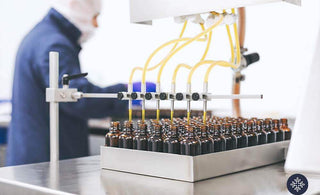While you may be familiar with the two most famous cannabinoids, tetrahydrocannabinol (THC) and cannabidiol (CBD), there are actually over a hundred cannabinoids naturally produced in hemp and marijuana plants.
A few of the more notable minor cannabinoids include cannabigerol (CBG), cannabinol (CBN), and delta-8 THC—an isomer of the notorious delta-9 THC molecule.
Cannabinoids are a class of therapeutic phytochemicals that contribute to the unique health properties of cannabis. Cannabinoids exert physiological effects by interacting with the endocannabinoid system (ECS).
Endocannabinoids are neurotransmitters that relay messages throughout the central nervous system (CNS) and peripheral nervous system (PNS).
The most abundant cannabinoids found in the cannabis plant are delta-9 THC and CBD. Minor cannabinoids such as CBN, CBG, and CBC make up the remaining bulk of the plant's cannabinoid profile.
CBN vs Delta-8: Comparison Effect
Fun fact: CBN was the first cannabinoid to be isolated from cannabis in the research of the intoxicating effects of marijuana. However, researchers found that it wasn't the primary psychoactive compound, but a byproduct of THC [4].
CBN is considered a minor cannabinoid found in more mature cannabis plants as THC starts to degrade from oxygen exposure. It has the potential to be mildly psychoactive in extremely high doses, but overall experts deem it a non-intoxicating compound as it's not used in high doses for its psychoactive properties.
What is Delta-8 compared to CBN
Delta-8 is a minor cannabinoid, which means it doesn't exist naturally in large quantities in hemp or marijuana plants. It's a degradation of delta-9 THC as the plant ages. Some experts believe the compound is much more shelf-stable because of this.
Many people are turning to delta THC products, derived from hemp crops or synthesized by processing CBD, as a legal way to experience a marijuana high. Since the delta-8 comes from Farm Bill compliant hemp crops, it exists in a legal grey area.
Other than that, it's known recreational use, THC including in forms like THC drops and gummies is an appetite stimulant, used to support muscle and joint discomfort, as a sleep aid, and a tool for introspection and personal-growth.
THC has a very similar molecular shape as the body's primary endocannabinoid, anandamide (aka the bliss molecule).
Anandamide and THC bind to CB1 cannabinoid receptors in the central nervous system. Activation of the presynaptic CB1 receptors is believed to cause most of the feelings of euphoria, changes in perception, and neural excitability.
Effects of CBN vs Delta 8 and 9
CBN has been studied for its benefits towards healthy post-workout recovery, maintaining healthy brain function, and sleep support.
Because CBN is a metabolite of THC, research suggests that it increases the effects of THC, producing more pronounced intoxicating effects and drowsiness when taken together nick-naming it the "sleepy cannabinoid" [5].
There's an emerging trend in the cannabis industry of marketing minor cannabinoids as specialized isolate products. However, there's no supporting evidence to suggest that CBN or any cannabinoid as an isolate could produce increased benefits over full spectrum or broad spectrum hemp extracts.
As you can expect, there are a lot of similarities in the effect profiles of CBN, CBG compared to delta-8 and delta-9 THC.
Many people call it a cross between CBD and THC. It is psychotropic but offers a milder and much more clear-headed high, making it a preferable option for first-time cannabis users and those who are prone to feelings of anxiousness when they consume marijuana.
As a sleep support, CBN has been the top choice for most compared to CBG and other cannabinoids. While CBG can offer calming effects, these effects have not yet been tied to improving sleep.
CBG vs Delta 8 & 9 THC?
When it comes to the most famous active compound in the cannabis plant, THC is at the top of the list.
However, CBG (cannabigerol) is the parent molecule to THC and CBD. It's most abundant in young hemp plants, but as the cannabinoid matures, it transforms into the more biologically active cannabinoids. It's only gained more popularity in recent years, but these studies give insights into CBG's potential as a starring cannabinoid.
Like CBD, CBG is non-intoxicating. In fact, it may have properties that counteract the psychoactive effects of THC, which may reduce some of the adverse effects of the compound [6]. When taken together, CBG may amplify some health benefits of THC, such as discomfort relief or relaxation, without increasing the high, allowing for a more balanced and potentially stronger overall effect.
CBG shows potential for supporting brain health, possibly leading to a greater capacity for focus and attention. Many people are reaching for cannabigerol (CBG) oil and gummies as their new favorite productivity tool to help with focus and sustained energy levels through grueling or mentally straining tasks.
Similar to CBD, CBG helps slow the breakdown of the neurotransmitter GABA in the brain. Higher levels of GABA may have potent calming effects that help to regulate stress and mood [7].
CBG as an isolate is difficult to source, as it requires harvesting hemp plants before maturity to yield higher concentrations of it. For those seeking the pure effects of CBG, pure CBG isolates powders are available, offering a potent option despite excluding many other compounds. Like the other cannabinoids, CBG is better in a group than a solo act.
That being said, THC is the most abundant cannabinoid in mature marijuana plants, and it's the primary psychotropic compound that's responsible for the intoxicating effects. While there's a growing amount of research on the benefits of THC and some states have even legalized its use for medicinal treatment programs and recreational use, THC remains federally illegal.
THC when combined with CBG also includes interactions with our immune system to support normal inflammatory function, mediating receptors involved with the perception of soreness, and elevating neurotransmitter levels in the brain that regulate mood [3].
How to look at the Cannabinoid Profile
The term “strain” doesn't have an official botanical meaning.
You may be familiar with the fact that hemp and marijuana are the same cannabis plant. The main difference between the two lies in the THC content, denoting its psychoactive properties.
In the United States, any cannabis plant with more than 0.3% THC content by weight is considered a marijuana plant, and it's a federally restricted substance, although certain states have legalized it for recreational use.
When we get into “strains,” “cultivar,” or “variety,” people are generally referring to strains of cannabis plants that have a distinct look, scent, and effect profile largely due to their cannabinoid and terpene makeup—Similar to how a chihuahua and a husky are wildly different but belong to the same species of domesticated dogs or Canis lupus familiaris.
What Are The Differences Between These Cannabinoids?
Cannabinoids are like a key and the receptor sites are locks. Cannabinoids have unique molecular shapes that make them fit into receptors to elicit a certain action. For example, the molecular shape of THC fits the CB1 receptor in the brain to produce intoxicating effects [1].
While cannabinoids like THC, CBD, CBG, and CBN share some similarities, their unique molecular structures interact differently with the endocannabinoid system, leading to distinct effects. For example, comparing CBG, CBN, and CBD reveals nuanced differences in how they may support focus, relaxation, and overall wellness.
CBN, CBG vs. Delta-8 & THC

If you're looking to enjoy the benefits that the hemp plant has to offer, look for full spectrum or THC- or broad spectrum extracts that take advantage of the natural plant synergy of delta-8, CBG, and CBN.
With more research emerging about the benefits of minor cannabinoids, you may encounter CBD brands offering CBN or CBG isolates as the “best new cannabinoid.” However, there's no evidence to support that any cannabinoid, CBD included, is best consumed on its own.
As a best consumer practice, always refer to a company's third-party lab testing report to read the hemp extract profile. This should provide information on the cannabinoids and terpenes present and their respective quantities, along with a contaminant report (pesticides, mycotoxins, solvent, and mold).
Resources:
- Stadler, R. H., Robert, F., Riediker, S., Varga, N., Davidek, T., Devaud, S., ... & Blank, I. (2004). In-depth mechanistic study on the formation of acrylamide and other vinylogous compounds by the Maillard reaction. Journal of agricultural and food chemistry, 52(17), 5550-5558.
- Grotenhermen, F., Russo, E., & Zuardi, A. W. (2017). Even high doses of oral cannabidiol do not cause THC-like effects in humans: Comment on Merrick et al. Cannabis and Cannabinoid Research 2016; 1 (1): 102–112; DOI: 10.1089/can. 2015.0004. Cannabis and Cannabinoid Research, 2(1), 1-4.
- Landmark, C. J., & Brandl, U. (2020). Pharmacology and drug interactions of cannabinoids. Epileptic Disorders, 22, S16-S22.
- Pertwee, R. G. (2006). Cannabinoid pharmacology: the first 66 years. British journal of pharmacology, 147(S1), S163-S171.
- Russo, E. B. (2011). Taming THC: potential cannabis synergy and phytocannabinoid‐terpenoid entourage effects. British journal of pharmacology, 163(7), 1344-1364.
- Cascio, M. G., Gauson, L. A., Stevenson, L. A., Ross, R. A., & Pertwee, R. G. (2010). Evidence that the plant cannabinoid cannabigerol is a highly potent α2‐adrenoceptor agonist and moderately potent 5HT1A receptor antagonist. British journal of pharmacology, 159(1), 129-141.
- Banerjee, S. P., Snyder, S. H., & Mechoulam, R. A. P. H. A. E. L. (1975). Cannabinoids: influence on neurotransmitter uptake in rat brain synaptosomes. Journal of Pharmacology and Experimental Therapeutics, 194(1), 74-81.


